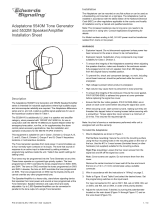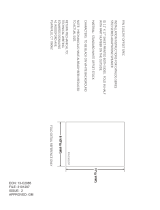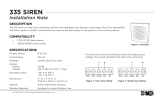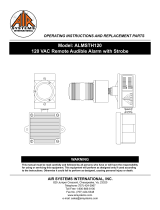
P/N 3100008-EN • REV 06 • ISS 14JAN15 1 / 8
5531M and 5531MV Series
Adaptatone Installation Sheet
Description
The 5531M and 5531MV Series Adaptatone signals are intended for
industrial applications where high audible output and microcomputer
reliability are required. The 5531M and 5531MV Series (Adaptatone
Millennium) are for indoor/outdoor use, and are UL and cUL Listed as
Audible Signal Appliances for use in the hazardous locations listed in
Table 1.
The device operates from local power. It accommodates up to four
normally-open contacts on its inputs. The tone that sounds in response
to an active input is determined by setting miniature programming
switches inside the unit. Table 6 shows the switch settings for the
available tones.
Four tones may be programmed into the unit at any time. These tones
operate on a pyramid-type priority system. The tone programmed on
SW1 overrides the tones programmed on SW2, SW3, and SW4. The
tone on SW2 overrides the tones programmed on SW3 and SW4.
Likewise, the tone on SW3 overrides the tone programmed on SW4.
The tone programmed on SW4 has the lowest priority and cannot
override any other programmed tone.
The speaker direction and the output level are easily adjustable.
This equipment is suitable for use in Class I, Division 2, Groups A, B,
C, and D; Class II, Division 2, Groups F and G; Class III hazardous
locations or nonhazardous locations.
Installation
The device may be mounted on any flat surface or may be used as a
freestanding unit mounted on a rigid pipe. The Adaptatone must be
installed in accordance with the latest edition of the National Electrical
Code or other regulations applicable to the country and locality of
installation and by a trained and qualified electrician.
For model numbers ending in AQ, 24 VAC power must be transformer
isolated from mains or line power.
WARNINGS
• Explosion hazard. Do not disconnect equipment unless power has
been removed or the area is known to be nonhazardous.
• Explosion hazard. Substitution of any components may impair
suitability for Class I, Division 2.
• To ensure integrity of the Adaptatone assembly when adjusting the
speaker direction, make sure threads in the enclosure remain fully
engaged and do not turn speaker more than 360 degrees from the
original factory installed position.
• To prevent fire, shock, and component damage, no work, including
circuit board removal, should be performed while the circuit is
energized.
• High voltage is present when the product is energized.
• High volume may cause harm to personnel in close proximity.
To ensure integrity of the enclosure:
• Be sure that the cover gasket, P/N P-007549-0069, is adhered into
the groove at the cover perimeter before replacing the signal box
cover.
• Be sure that the four collar gaskets, P/N P-041930-0362, are in
place on each cover screw before securing the signal box cover.
• When securing the cover, start the screws by hand, making sure
that they are threaded into the tapped holes in the housing bosses
before securing them with a screwdriver. Torque the signal box
cover screws to a minimum of 20 in-lbs. This ensures the required
tight fit.
Note: Any kind of service or maintenance performed while the unit is
energized will void the warranty.
To install the Adaptatone:
1. Mount the Adaptatone as shown in Figure 1.
Flat Surface mounting: Secure the unit to the mounting surface
using the four mounting holes in the mounting plate on the rear of
the box. Use the #10 × 3 wood screws (furnished loose) or other
hardware (not supplied) suitable for the mounting surface.
Rigid Pipe mounting: Loosen the four cover screws from the
signal box and lift off the signal box cover.
Note: The cover screws are captive. Do not remove them from the
cover.
Remove the center knockout in the lower wall of the box and
mount the box on a 1/2 in. conduit pipe using a suitable connector.
2. Wire in accordance with the instructions in “Wiring” on page 2.
3. Refer to Figure 5 and Table 6 and select the desired tones. Set the
miniature programming switches on the input board.
For input connected to IN1, set on SW1; IN2, set on SW2; IN3, set
on SW3, and IN4, set on SW4, in order of priority desired.
4. Adjust volume level, if desired, by turning the potentiometer
located on the main board (Figure 5 and Figure 6).
5. Tightly secure the signal box cover using four retained cover
screws.
6. Torque signal box cover screws to a minimum of 20 in-lbs.
7. To adjust speaker direction, loosen the large star nut (Figure 1)
and turn the speaker to the approximate desired position.
Retighten the nut and turn the speaker slightly clockwise until it is
locked into place.
Regardless of speaker direction adjustment, it is important that the
star nut be tightened wrench tight to ensure that the speaker
position is maintained securely.
8. Verify operability.













